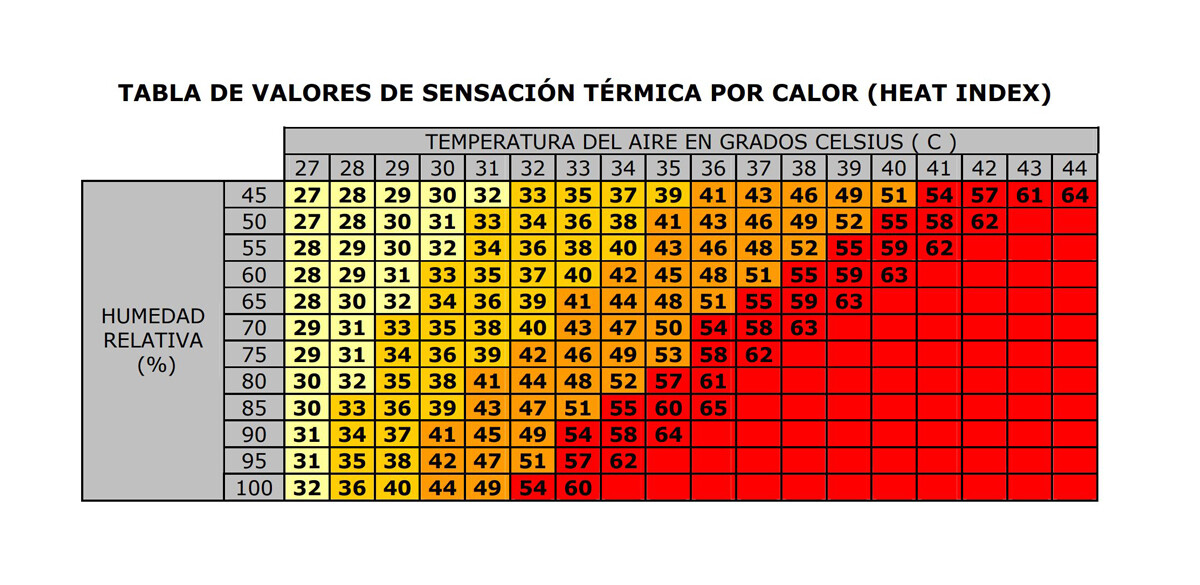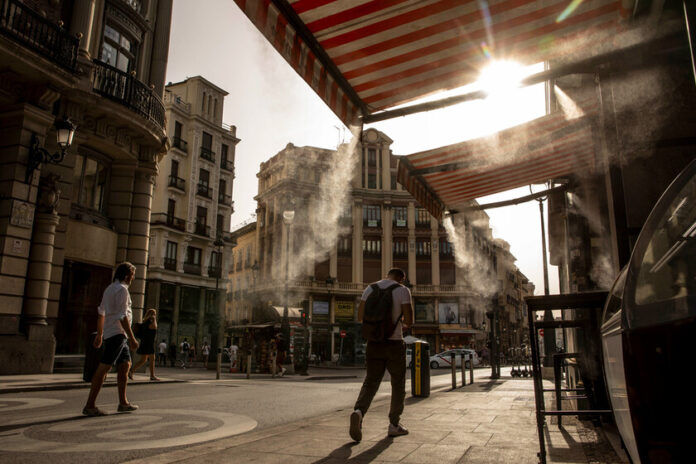We are used to hearing complaints about the humid cold, but surely humidity is worse when it accompanies high temperatures. Just a few weeks ago we were talking about a heat wave sweeping across India, where extreme heat combined with high humidity to create a death trap. These days we have seen the thermometers rise in Spain, so it is worth asking ourselves if it is possible that we find ourselves in a situation in which the humid temperature can play tricks on us.
How is the heat index measured?
Wind chill is measured in different ways in cold (wind chill index) and warm (heat index) temperatures. While in the cold it is measured as a function of temperature and wind, with the heat it begins to depend on temperature and relative humidity. This last measurement also corresponds to the heat index.
The State Meteorological Agency, AEMET, (which is the one who calculates the thermal sensation) explains that it is a measure that “helps to assess the greater difficulty that the body has in lowering body temperature through the evaporation of sweat on the skin. due to the effect of ambient humidity. The heat index begins to be controlled from 26ºC and a relative humidity of 40%. Although the formula with which it is calculated is complex, the effect is simple: at high humidity the index adds several points to the temperature.

AEMET table summarizing the equivalences between the heat index and its components (temperature and relative humidity).
How does this translate?
Thus, with a temperature of 27ºC and a humidity of 45%, the index will be 27, but if the humidity rises to 80%, the index will be 30, that is, the thermal sensation will be 30ºC. Similarly, at 32ºC and with a humidity of 45% the index will indicate 33, but again if the humidity rises to 80%, the wind chill will reach 44ºC.
When the index reaches 27, caution is advised. If the index is between 33 and 40, AEMET already recommends extreme caution. Between 41 and 53 we speak of danger, and from a heat index of 54 the level of extreme danger is reached. There are also other tools to calculate this index.
The case of Spain.
It is clear that hot and humid places like India can suffer from this problem, but what about Spain? In much of the Iberian Peninsula the climate is rather dry, and more so in summer. However, a relative humidity between 45 and 50% is enough to create danger during heat waves, since those levels would imply that a temperature of 35ºC feels like one of about 40ºC. If the mercury reached 40º we would already be on the threshold of the extreme danger zone.
As a reference, suffice it to say that, in the month of July, the average relative humidity in Extremadura is around 45%, and although in Madrid it remains at 40%, in Andalusia and Murcia, on the other hand, its average value is around 60%.
To this must be added the uncertainty generated by climate change, which can have effects on both temperatures and humidity (not necessarily in the same direction.
It is not the same as heat waves.
The heat index is not directly related to heat waves. There is no exact definition of what constitutes a heat wave, but referring to the definition given by AEMET, a heat wave would be a situation in which, for a minimum of three days, higher temperatures are reached “[al] 95% percentile of its series of maximum daily temperatures for the months of July and August for the period 1971-2000” (in at least 10% of the meteorological stations.
The 95th percentile is calculated by ordering by temperature all the days of July and August of the reference years, after which the group of 95% of the coldest days is taken. The warmest of those days will be the one that marks the 95th percentile. (Alternatively, the coldest day of the 5% of the warmest days can be taken, the result will be similar or the same).
Why humid heat is dangerous.
The humid heat, the embarrassment, can be especially dangerous for the health. Our body has several mechanisms to control our body temperature, but humid heat makes it difficult for this internal “thermostat” to work.
The problem arises because one of these mechanisms that we use to lower body temperature when it rises too high is sweat. Our body expels sweat, mainly water, which absorbs this body heat. When evaporating that heat passes to the environment. But the ability of sweat to evaporate depends on the humidity of your environment: the more humidity, the harder it is for sweat to evaporate. The sweat that does not evaporate remains on our body as a layer of hot water and therefore does not fulfill its thermoregulatory function.
Heat is especially dangerous for older people, but there are many factors that impact this risk. The Ministry of Health indicates personal factors such as age or suffering from certain diseases, social and labor factors such as socioeconomic status and exposure to heat at work, and local factors such as the climate itself.
How to deal with the humid heat.
When the heat arrives, the first thing we consider is trying to escape from it. Surely going to the beach or a pool is the preferred option for many, especially in times when turning on the air conditioning is (even more than other years) a luxury. Fans, in addition to consuming power like air conditioning, can be useless, and even counterproductive, when the temperature rises above 32ºC. There are many other strategies for the rest of the day, including paying attention to the usual recommendations, such as avoiding exposure to the sun or physical activity in the hottest hours of the day.
Cover image | Daniel Gonzalez/GTRES














